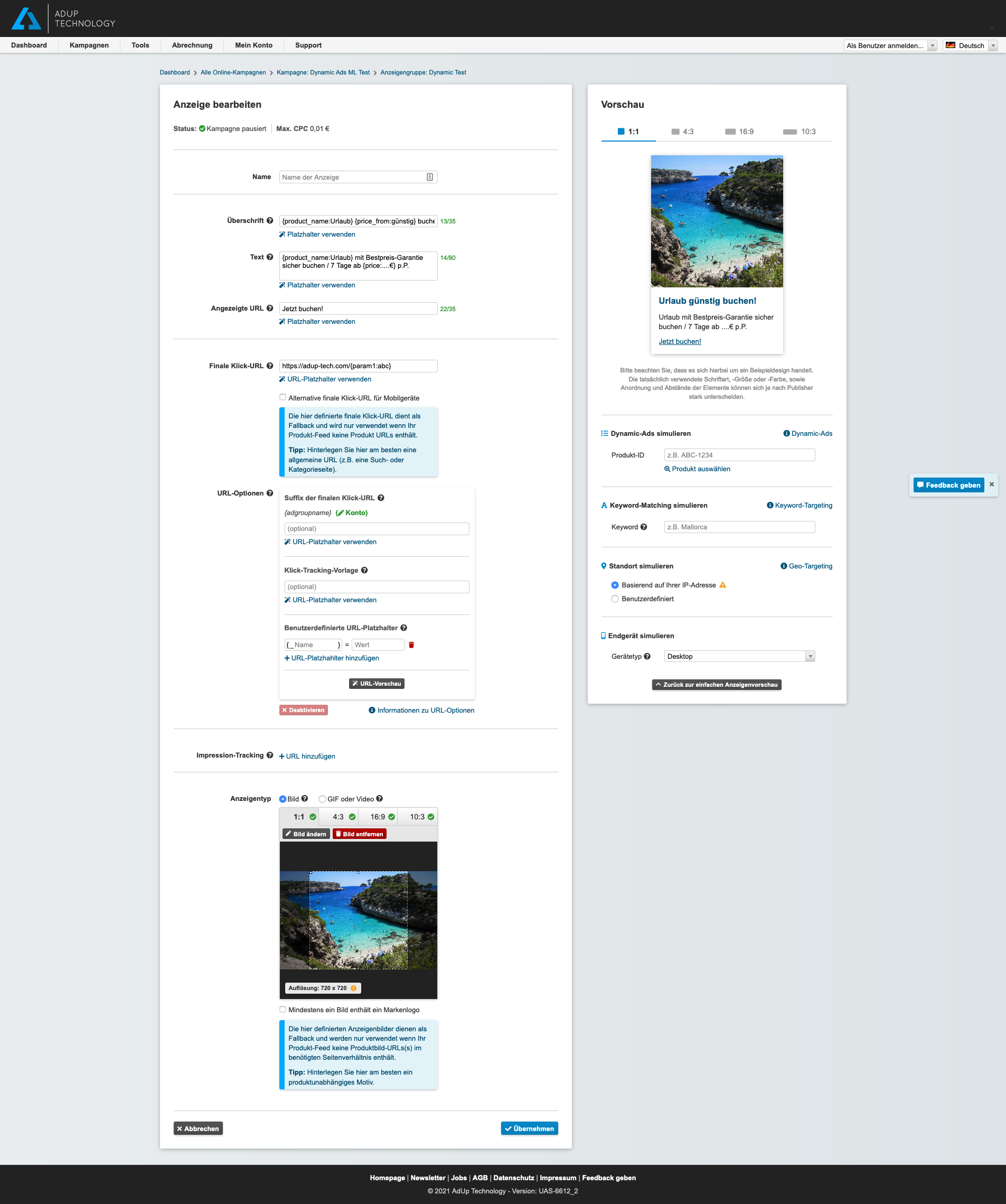What are Dynamic Ads?
Dynamic ads are ads that are reassembled by building blocks in the ad texts for each delivery. The content adapts either to the identified keywords, geo-location or retargeting information (which product they last viewed on your site, if they were already there).
Is that interesting for me?
Dynamic ads are particularly suitable for keyword campaigns. Here, determined keywords are mapped in the content of dynamic ads. Dynamic ads are just as interesting for retargeting campaigns. Here, the content of the ad can be filled dynamically based on the last product viewed. In this way, you only need a few ads and ad groups to create completely individual ads for your user address.
The prerequisite for both is the use of a product feed. Learn more about this in this support article. The product feed is a (small) database that outputs the appropriate information for the placeholders of your dynamic ads based on the user information or input.
What do I have to do?
Basic
In ad editing, you can enter the following in the texts for
- Headline,
- description,
- displayed URL and
- Click URL
placeholders in the texts. For example, write '{product_name: holiday} {price_from: from 50 EUR}' in the headline. If the user now reads 'France', the placeholder product_name is replaced with the content of the linked feed entry, in this case 'France', and the appropriate price is given ('France from 140 EUR'). For this, your product feed must contain the destinations with the placeholder 'product_name' as well as the price information under 'price_from'. The entry of 'holiday' and 'from 50 EUR' serve as fallback text and are used if the available characters are exceeded.
How does it work?
The product ID establishes the connection between a keyword and the corresponding entry in your product feed. It is therefore essential that each keyword in a Dynamic Ads campaign has a final click URL with a matching product ID as a URL parameter. Several keywords can have the same final click URL and thus the same product ID. If no keyword matching takes place or the given keyword does not have a final click URL or an invalid product ID, the fallback values of the placeholders in the ad texts are used.
Dynamisation can also be used for direct placements. According to the same principle, the product ID parameter is also used in the final click URL of an ad. Thus, the placeholders are replaced with dynamic elements from the feed.
Example
You define the query parameter "pid" as the position of the product ID for your "Dynamic-Ads" campaign and the given keyword has the final click-URL "https://www.example.com?pid=123". The ID "123" is now searched for in your stored product feed and the corresponding placeholders in the ad texts are replaced with the values from the product feed (e.g. name or price). If you have also stored an image URL in your product feed, the respective image will be used for the displayed ad.
Notes
What should you consider in the headline?
- Use the headline to give the most important information about your offer - usually location, price or discount or voucher. This is where they are most visible to the user.
- Formulate the headline text in such a way that the most important content is at the beginning, if you use the ellipsis placeholder - this shortens keywords that are too long at the end with [...].
- Consider whether you can also write a good headline using only placeholders, this way you save characters and long keywords can be used without abbreviations or fallbacks. Use the "Fit placeholders" for this.
- Check if you use two ad groups to differentiate between keywords of different lengths - write two ad headlines and texts, one for the group with longer keywords and one with shorter ones. This way, your dynamically created ads will fit the content for each keyword length.
- Do you know the placeholder price_from? The "from" is already part of the replacement and does not have to appear in your headline. Use it to formulate ad texts in such a way that the fallback text is also round.
- Where can you save characters? Enter the price without decimal places!
What belongs in a good ad text?
Here you can refer to further information, evaluation or USP, but also branding information such as company, organiser or group.
What is important in the displayed URL?
It is best to use your simple domain here. It gives the user orientation. Note that you should leave out www. and https or similar to avoid irritation and improve the click rate.
What should you pay attention to in the click URL?
Use your normal homepage URL only as a fallback solution. It is much better to dynamically replace the click URL with the product feed. This will take the user directly to the page on your website that is associated with the keyword he or she has already searched for.
What should be considered when tracking?
If you use tracking parameters, add them to your campaign. The product feed is not suitable for this, as you should create it for the entire account and all the campaigns it contains.
What should you consider with your image?
Use the dynamic function of the ads and use images based on the user's keywords. For example, you can display an alpine panorama for a search for 'Oberstdorf' and white sandy beaches for 'holiday by the sea'. There should be at least one image URL in the feed. Ideally, there should even be a separate image URL for each of the four image formats.
